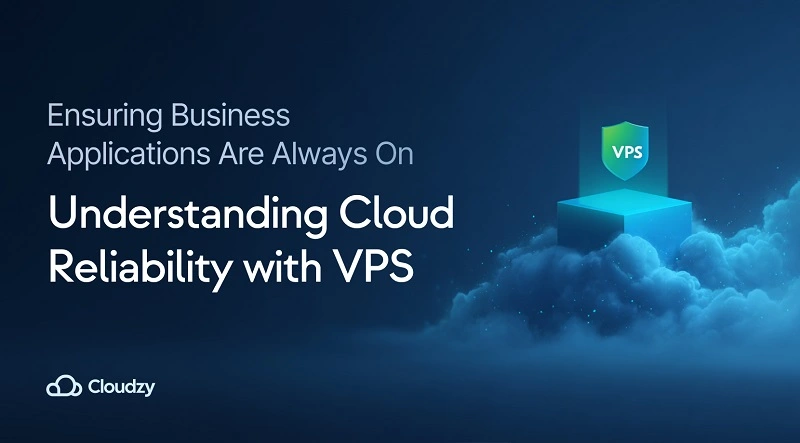Running a company’s daily operations on cloud‑based platforms calls for a reliable business application hosting VPS from day one. Lost carts, frozen dashboards, and panicked calls from the sales floor all trace back to the moment an application times out. Revenue does not pause politely; it simply slips away.
That reality is why a reliable business application hosting VPS has become the first line of defense for any team that bills, ships, or supports customers online. Over the next few minutes, we’ll trade uptime buzzwords for step‑by‑step routines your staff can follow without hiring an extra engineer, and we’ll keep every example squarely in small‑business territory so the guidance feels achievable.
When Your Business Apps Go Down, Business Comes to a Halt!
Nothing underlines availability like the moment a dashboard freezes. Mailboxes pile up, customers repeat orders, and staff look at you for answers. Without a reliable business application hosting VPS, every other improvement plan pauses.
- Missed transactions translate into direct revenue loss.
- Staff productivity dips as they chase manual workarounds.
- Customer patience shrinks; competitors look more attractive.
- Support tickets spike, stretching a lean help desk.
Industry surveys peg the cost of downtime at roughly four thousand dollars per minute for mid‑market retail. With a reliable business application hosting VPS, that number drops because outages become shorter and easier to predict through testing.
A single incident proves why adopting a VPS for high availability business apps and tactics that minimize application downtime with a VPS should rank beside marketing in your budget spreadsheet.
What “High Reliability” or “Uptime” Means for Your Apps
Targets like 99.9 percent sound abstract until you convert them— that figure equals 43.8 minutes of monthly disruption. With a reliable business application hosting VPS, tightening the goal to 99.95 percent becomes affordable. And that’s an up-time rate we guarantee for your business. Learn more about our Windows VPS and Linux VPS services.
- Application uptime: measurable time a service accepts requests.
- Service availability target: the percentage management signs off on.
- Redundancy (simplified): duplicate resources ready on standby.
- Failover plan: prewritten steps the on‑call engineer follows.
- System monitoring: continuous probes that send alerts long before users complain.
Service levels rely on design decisions. Pick a capacity tier, compute redundancy, and monitor cadence that all match revenue impact. By treating your virtual machine as a reliable business application hosting VPS, you align tech choices with boardroom objectives rather than guesswork.
Documenting these metrics builds confidence and lays the groundwork for business continuity solutions for SMBs that crave enterprise steadiness at a neighborhood budget.
Can One VPS Be Highly Reliable? Yes, with Good Management
A single node can shrug off everyday turbulence when configured with care. Treat your reliable business application hosting VPS like a living system, not a static appliance.
- Allocate vCPU and RAM to cover normal load plus a safety margin.
- Schedule automated snapshots every hour.
- Keep a floating IP ready, so you can swap instances in minutes.
- Apply kernel live patches to close vulnerabilities without reboot.
Take the case of a manufacturing firm in Munich. They migrated an aging on‑prem ERP to a reliable business application hosting VPS, and downtime immediately fell from weekly hiccups to two brief incidents per year. The secret was disciplined patching and snapshot rotation.
Those habits keep a VPS for high-availability business apps humming and minimize application downtime with a VPS far better than many shared plans.
Simple Idea: A Backup VPS Ready to Take Over
Seatbelts cost little until you need them. The same goes for a warm standby. Pairing production with another reliable business application hosting VPS in a different zone gives you minutes, not hours, to recover.
| Component | Primary VPS | Backup VPS | Action During Failover |
| Compute | Handles live traffic | Sized to match production | Traffic rerouted via floating IP |
| Data Replication | Real‑time block sync | Receives ongoing updates | Promoted instantly |
| Monitoring | 60‑second health probe | Passive heartbeat | Alert threshold resets |
| Maintenance | Rolling package updates | Same updates after promotion | Version parity retained |
Testing failover every quarter is vital. Spin up the backup, switch the floating IP, and monitor order processing throughput. A drill like this proves the backup is a truly reliable business application hosting VPS, not just a dormant template.
This design brings classic business continuity solutions for SMBs within reach. Many teams decide to buy cloud server capacity in two regions to spread risk.
Keeping Your Application Data Safe and Synced
Uptime means nothing if your ledger shows last week’s numbers. Data consistency must travel alongside your reliable business application hosting VPS planning.
- Choose transaction‑aware replication engines such as Galera or logical decoding.
- Encrypt transfers with TLS 1.3, guarding records in flight.
- Run integrity checks that compare row counts on both nodes.
- Store daily point‑in‑time backups for silent corruption recovery.
A common fear is data lag during replication. Modern engines support incremental snapshots that complete in seconds, letting your reliable business application hosting VPS accept writes even while a bulk transfer runs. That technical detail keeps accounting ledgers and customer carts fully in sync.
These steps minimize application downtime with a VPS by eliminating the need for manual data stitching after a failover, guaranteeing business continuity solutions for SMBs that lack a full DBA staff.
Keeping business data safe is half the uptime battle, and strong encryption paired with off-site backups tackles most everyday threats. Our walkthrough on cloud data protection dives into retention policies and zero-knowledge backups that small teams can adopt in an afternoon. Pair those habits with a reliable VPS, and downtime stops taking payroll hostage.
Choosing a VPS Provider Focused on Uptime for Businesses
Features matter more than slogans. Evaluate each vendor’s track record before moving a single workload.
- SLA offering at least 99.95 percent availability.
- Data Centers connected by private backbone links.
- Native snapshot, firewall, and DDoS filtering.
- Transparent incident timeline and public status page.
Cloudzy backs its reliable business application hosting VPS promise with hard numbers: 99.95 percent SLA, NVMe SSD storage, and KVM isolation across more than fifteen global data centers. Real‑time Grafana dashboards, automated scaling, and free DDoS filtering keep a VPS for high availability business apps steady without nightly maintenance windows.
You can spin up a Nextcloud VPS in under sixty seconds, pick the closest region, and toggle managed backups from the same screen where you buy VPS capacity. Cloudzy’s mix of edge points and core hubs bridges the gap often seen between Private Cloud Providers and Public Cloud Providers, while offering truly scalable VPS infrastructure for business growth—moving from a starter 2 GB plan to a load‑balanced cluster never involves ticket battles. If you need to buy cloud server resources for seasonal spikes or a new market launch, the upgrade path takes a single click.
| Criteria | Cloudzy | Typical VPS Vendor |
| Guaranteed Uptime | 99.95 percent | 99 percent |
| Storage Medium | NVMe SSD | SATA SSD |
| DDoS Protection | Included free | Paid add‑on |
| Global Locations | 15+ regions | 3‑5 regions |
| Backup Snapshots | Automated daily | Manual setup |
| 24/7 Support | Live chat & ticket | Email queue |
Populate a sheet like this during your evaluation cycle, and the most reliable business application hosting VPS option usually surfaces quicker than an hour‑long sales demo.
Final Thoughts
Investing in a carefully crafted, reliable business application hosting VPS eliminates the knee‑jerk chaos that follows unexpected outages. By combining resource headroom, real‑time replication, and a vendor that treats transparency as policy, you meet uptime goals and keep cash flow steady. These same principles have guided my own deployments, and I can vouch for the calm they bring on launch day.
Finally, remember that uptime is never a one‑time purchase. A reliable business application hosting VPS needs periodic review, just like insurance policies. Schedule semi‑annual architecture audits, verify backup restores, and refresh documentation. Do that, and the next outage headline will involve someone else’s site.



